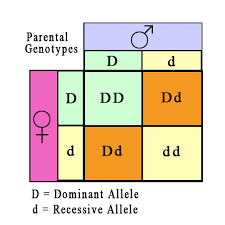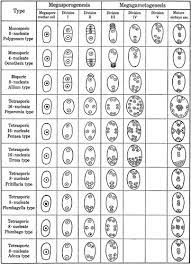Endosperm - definition, types
ENDOSPERM
Definition:
Endosperm is unique among the plant tissues with regard to
its origin and development.
Endosperm is the most common nutritive tissue for the
developing embryo in angiosperms.
Endosperm is the product of fertilization and is triploid. After double fertilization the egg is called zygote, and the fusion product of polars and the second ale gamete is termed as the primary endosperm nucleus. The former develops into an originated embryo whereas the latter gives to an almost formless tissue, the endosperm.
- Nuclear endosperm
- Cellular endosperm
- Helobial endosperm
- Cereal endosperm
- Ruminate endosperm
Nuclear endosperm:
In this
type of endosperm the division of the primary endosperm nucleus and few
subsequent nuclear divisions are not accompanied by wall formation. This results
in a condition where the central cell of the embryo sac has formed a few to
several thousand nuclei freely suspended in its sap. Such a condition of
endosperm may persist toward the center. The degree of cellularization varies a
great deal. Mostly the endosperm becomes completely cellular but in Phaseolus cellularization
occurs only around the embryo. In crotalaria the wall formation is confined to
the upper region of the embryo sac; the Chalazal region remains free-nuclear,
and it often elongates and behave like an haustorium.
Development
of endosperm in coconut deserves special mention. The primary endosperm nucleus
undergoes a number of free nuclear divisions. When the fruit is about 50mm long
the embryo sac gets filled with a clear fluid in which float numerous nuclei of
various sizes. At a later stage the suspension shows, in addition to free
nuclei, several cells each enclosing a variable number of nuclei. Gradually these
cells and free nuclei start settling at the periphery of the cavity, and layers
of cellular endosperm start appearing. This forms the coconut meat. The quality
of the cellular endosperm increases further by the divisions of the cells. In mature
coconuts the liquid endosperm becomes milky, and it does not contain free
nuclei or cells.
Cellular endosperm:
The cellular
endosperm is characterized by the absence of free-nuclear stage. The division
of the primary endosperm nucleus and a few subsequent nuclear divisions are
followed regularly by wall formation. In avocado, the wall formed after the
first division of the primary endosperm nucleus is probably callosic. The occurrence
of haustoria is a common feature of this type of endosperm; it is more varied
than that in the nuclear endosperm. The haustoria may be micropylar or
chalazal. Occasionally, both types of haustoria are present in the same plant. The
first division of the primary endosperm nucleus is followed by a transverse
wall resulting into two chambers of almost equal size. Divisions in the
micropylar chamber are rapid and in all directions. The chalazal chamber
divides transversely and at a comparatively slow rate. This results in a tail-like
chalazal part attached to the more massive tissue at the micropylar end. Further
divisions occur in the upper part of the tail and add to the endosperm tissue. The
basal two or three cells of the tail elongate to form an haustorium which
penetrates into the chalazal part of the nucellus.
Helobial endosperm:
In this type of endosperm is
restricted largely to the monocotyledons. The primary endosperm nucleus moves
to the chalazal end of the embryo sac where it divides forming a larger
micropylar chamber and a small chalazal chamber. In the micropylar chamber, as
a rule, free-nuclear divisions and cell formation, if any, start at a much
later stage. In the chalazal chamber the nucleus either remains undivided or
divides only a few times. If latter is the situation, the divisions are usually
free-nuclear. However, sometimes, as in Phylidrum lanuginosum, it
may becomes cellular.
Cereal endosperm:
In cereals the endosperm is of the free nuclear type. It is
generally starchy and dry at maturity but in 30 out of the 16 grasses surveyed
it remains liquid or soft even in mature seeds. Extensive work has been done on
the structure, physiology and genetics of endosperm development in grasses
because of its special structure and economic importance as the major source of
calories in food and feed. Fully differentiated endosperm of cereals, such as
maize and barley, consists of four distinct types of cells or tissues. Transfer
cells (TCs), Embryo surrounding cells (ESCs), starchy endosperm cells (SECs)
and Aleurone cells (ALCs).
Ruminate endosperm:
Mature endosperm
with any degree of irregularity and unevenness in its surface contour is called
ruminate endosperm. Rumination starts at a late stage of endosperm development,
and it may belong to anyone of the 3 categories described above. Ruminate endosperm
is known to occur in about 32 families of angiosperms.
Rumination
is caused by the activity of the seed coat or the endosperm itself. In the
former case, the irregularities on the inner surface of the seed of the seed
coat may arise by:
- Unequal radial elongation of anyone or the only layer of the seed coat.
- Definite ingrowth or infoldings of the seed coat.
The second cause is more common and is found in the Annonaceae and Aristolochiaceae.
Functions of endosperm:
- It is the nutritive tissue for the developing embryo.
- In majority of angiosperms, the zygote divides only after the development of endosperm.
- Endosperm regulates the precise mode of embryo development.
THE EMBROLOGY OF ANGISPERMS 6th EDITION Author; SS BHOJWANI, SP BHATNAGAR ,PK DANTU.






Comments